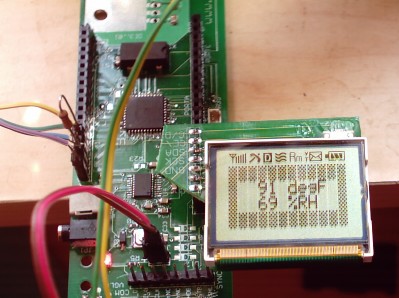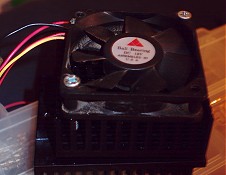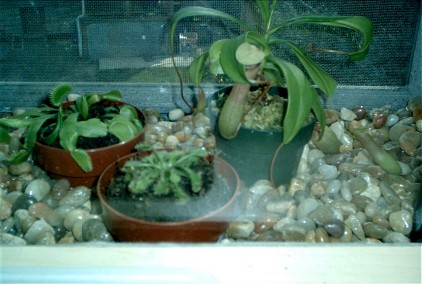Terrarium for hot, humid, picky little plants
Keeping my Boston-intolerant carnivores in cut-up 3-liter Coke bottles was a litte..um..ghetto, so I built this.

The box
It’s basically a regular off-the-shelf 10-gallon aquarium with a few extras thrown in. The lid is a seamless piece of Lexan from the hardware store. Lexan can be somewhat of a bitch to cut cleanly (splinters, shatters, etc.); one approach is to score it with a good knife and then snap it along the score lines. I took it to the lab, but all I could find on-hand was a little X-Acto knife, which after plenty of blood, sweat, tears etc. still hadn’t cut deep enough lines to snap the piece along. What I ended up doing was digging up some heavy-duty tin snips and cutting along the score lines. “Good ’nuff for guvmint work!” This left a bit of a rough edge, but it filed down nicely.
Climate control
Currently the terrarium holds a sprawling Venus flytrap, a pair of sundews and the Nepenthes that recently outgrew its soda bottle. These enjoy warm (but not baking) temperatures and require high humidity. In order to tell what’s going on inside the tank climate-wise, I rigged up a SHT11 sensor from work to a leftover prototype board. A simple microcontroller program converts digital values from the SHT11 to degrees and percent relative humidity, and displays it on the screen from my old phone. Values were also logged to a PC serial port for the first few days so I could find out how hot it was getting while I wasn’t home.

The vital stats reading out on the ouchbrick LCD
Humidifying a tank like this turns out to be less straightforward than it sounds. My first thought was that a small dish of water sitting inside would do the trick, but no such luck. Adding a sponge for added evaporation helped a bit, but still not enough. My next thought for humidity on-the-cheap was to pick up a small aquarium pump, and bubble air through a bottle of water. The bottle I originally tried was an intact soda bottle, on the theory that the narrow neck would prevent the bursting bubbles from splattering water everywhere. After 2 days I was able to conclude the bubbler approach did approximately jack squat for humidity, even when the pump itself was placed inside the tank (to recirculate rather than pumping in dry outside air). As a last ditch before relegating the air pump to my junk closet, I hastily cut the top off the soda bottle. Viola! Instant humidity – little drops of water get splattered all over the tank, giving plenty of surface area to evaporate from. With this in place, humidity hovers in the range of 78-90%.
On the right, a small CPU fan sits near the bottom and circulates the air around. For now it’s just fixed to the glass with a bit of poster putty.
Finally (for now), polished aquarium rocks were added to the floor of the tank – this not only looks nice and keeps the plants from falling over, it also covers over the wires and air hose and holds them in place. Hopefully the smoothness of the rocks will discourage algae growing all over them in the humid tank (or at least make it easier to clean off).
Next steps
Waiting to be added is a Peltier cooler bonded to a heatsink + fan on either side. This will allow the temperature inside the tank to be controlled by the micro, independent of air exchange (especially important in the dry winter) – the Peltier can heat or chill the tank depending on the polarity of voltage across it. By adding two switched 120V outlets, the humidity and photoperiod could also be controlled to some degree (grow lamp and the bubbler). It would probably look nicer to replace the aquarium bubbler with one of those little ultrasonic fog generators.

Peltier thermoelectric cooler – future addition

Happy plants – no more Coke bottles!
Leave a Reply